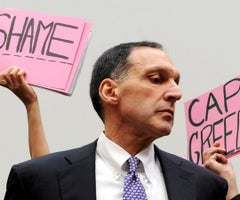MI SELECCIÓN DE NOTICIAS
Noticias personalizadas, de acuerdo a sus temas de interés

By James Mackintosh
Ten years after the failure of Lehman Brothers, the publishing industry is still churning out tracts on what went wrong and how to stop it from happening again. Investors need not involve themselves in arguments about the best form of bank regulation or how to restructure derivatives counterparties, but the collapse of Lehman offers plenty of important lessons, many of which still haven’t sunk in. Here are five.
1. Not every bubble shows up in excessive valuations. In the buildup to the financial crisis of 2008, the dot-com fiasco was still fresh in everyone’s mind. The line at the time was that valuations were nowhere near the insane levels reached at the end of the 1990s, so don’t worry about a bubble: Shares are fine.
This turned out to be as wrong as it was in 1929. The sad truth was that the bubble was in credit, and those looking at price/earnings ratios in stocks-or almost any other valuation tool-were misled because the precrisis bubble inflated the E in the P/E, not just the P. Today the forward P/E ratio is higher than it was at its 2007 pre-Lehman high, and again earnings are excellent and everything looks fine. Hopefully earnings are more sustainable than they were in 2007-2008, but various measures of the quality of earnings have fallen, and corporate leverage is high.
2. Liquidity vanishes in a crisis. Lots of investors bemoan the difficulty of trading, especially in corporate bonds, and worry that it might portend deeper troubles ahead. But 2008 showed the real danger lies in the belief that things that are easy to trade will remain so, because in a crisis they never are.
Back in 2007-2008, corporate bonds were the easy thing that became the hard thing. In the good years, primary dealers built up a huge inventory-$285 billion-that made the market more liquid than ever before. When they dumped their holdings the market rapidly became illiquid, and when serious trouble hit junk-bond yields soared to 23% as trading dried up. The more complex structured products that had been popular at the end of the boom years became impossible to buy or sell.
Today, dealers hold just $10 billion of net corporate bonds. The easy liquidity is instead in exchange-traded funds. But if buyers of bond ETFs believe they will be easy to dump in a crisis they are likely to be disappointed.
3. Long periods of calm lead to excess. The late economist Hyman Minsky came back into fashion after the financial crisis, which neatly fitted his description of the speculative cycle. A long period of growth, with only a minor interruption in 2001, led to complacency. Everyone was willing to borrow and banks were only too willing to lend, creating a virtuous cycle of rising asset prices and a stronger economy. When it went into reverse, the need to repay debts smashed asset prices and threw the economy into a deep recession.
Mr. Minsky’s final stage involves the widespread use of what he called “Ponzi debt,” loans that cannot be serviced from income but require capital gain to avoid trouble. At the peak of the 2007 cycle these were widespread in debt-financed takeovers, hedge-fund leverage, property speculation and highly geared investment structures, among other places. They are harder to find today, but tend to be easier to see with hindsight.
4. Financial innovations frequently go wrong. The late Charles Kindleberger documented how throughout history, reckless lending found its way around regulatory efforts to restrain the supply of money and credit. Innovations allowed the financial system to satisfy the demand for money and credit from euphoric investors and businesses by creating new money-like instruments, with money-market funds holding structured products one example from 2007. Credit funds and peer-to-peer lenders are today finding ways to satisfy demand for loans that postcrisis rules make the banks unwilling to offer, but the scale is, hopefully, still too small to create a crisis.
5. This time is almost never different. In 2007-2008 banks were thought to be safer thanks to their use of securitization and derivatives to shift risk to others. Rather than making things better, it meant no one knew where the risk lay and so everyone assumed the worst. For now bank resilience is mostly based on more and better capital and liquidity, but there has also been a rapid growth in complex ways to shift risk to funds, and in lending by nonbanks. The scale of the activities is small compared with 2007-at least outside China-but this could be a threat in future.
The good news is that the more households, executives and investors focus on the last crisis, the less likely they are to take the sort of excessive risks that could lead to the next one.
J.K. Galbraith summed it up beautifully in 1975 in the foreword to his sweeping “The Great Crash 1929”: “As a protection against financial illusion or insanity, memory is far better than law. When the memory of the 1929 disaster failed, law and regulation no longer sufficed.” The more investors keep harking back to 2007-2008, the less chance there is of a repeat. My worry is that, this 10th anniversary notwithstanding, memories are fading.
Así se acumula en Argentina un superávit luego de intereses equivalente a cerca del 0,2% del PIB en el primer trimestre del 2024
El cambio es un esfuerzo para "desescalar el rencor y darnos a todos la oportunidad de considerar los próximos pasos", dijo el presidente de Columbia Minouche Shafik en un comunicado
La empresa minera británica tenía una capitalización bursátil de US$36.710 millones al cierre del miércoles, según datos de Lseg